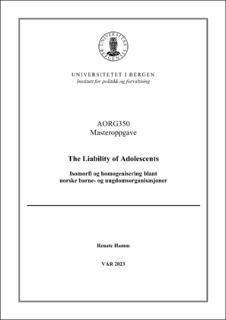| dc.contributor.author | Hamm, Renate | |
| dc.date.accessioned | 2023-08-01T23:50:37Z | |
| dc.date.available | 2023-08-01T23:50:37Z | |
| dc.date.issued | 2023-06-03 | |
| dc.date.submitted | 2023-08-01T22:01:22Z | |
| dc.identifier.uri | https://hdl.handle.net/11250/3082236 | |
| dc.description.abstract | Denne oppgaven undersøker hvorvidt teori om institusjonell isomorfi kan forklare en potensiell homogenisering blant norske barne- og ungdomsorganisasjoner. Caseutvalget for denne studien består av fire norske frivillige barne- og ungdomsorganisasjoner: KFUK-KFUM Norge, Norsk Speiderforbund, 4H Norge og Humanistisk Ungdom. Gjennom en kvalitativ innholdsanalyse av landsmøteprotokoller fra den enkelte organisasjonen fra år 2000 til år 2022, har man kommet frem til at organisasjonene utviser flere likhetstrekk innenfor både institusjonelt drevne og det kompetitivt drevne organisatoriske endringer, særlig det siste tiåret. Det er spesielt de samfunnsbaserte organisasjonene som utviser slike trekk. Analysen har også funnet størst innslag av tvungen isomorfi, og dernest kompetitiv isomorfi. Som konsept viste tvungen isomorfi seg å være for bredt for denne analysen, og det var derfor nødvendig å skape to nye underkategorier: Institusjonelt-tvungen isomorfi og teknisk-tvungen isomorfi. Studien har vist at organisasjonene utviser mest isomorfi som følge av press og krav fra sine institusjonelle omgivelser samt fra sin demografiske målgruppe, og mindre som følge av krav og ønsker fra sine tekniske omgivelser. | |
| dc.description.abstract | This thesis examines whether institutional isomorphism theory can explain a potential homogenization among Norwegian youth NGOs. The case selection for this study consists of YMCA-YMWA Norway, Norwegian Guide and Scout Association, 4H Norway, and Humanist Youth. Through a qualitative content analysis of national meeting minutes from each organization from the year 2000 to 2022, it has been found that the organizations exhibit several similarities in both institutionally driven and competitively driven organizational changes, particularly in the last decade. It is particularly the community-based organizations that exhibit isomorphic features. The analysis also found the highest incidence of coercive isomorphism, followed by competitive isomorphism. As a concept, coercive isomorphism was found to be too broad for this analysis, and it was therefore necessary to create two new subcategories: Institutionally coercive isomorphism and technically coercive isomorphism. The study thus found that the organizations exhibit the most institutional isomorphism due to pressures and demands from their institutional environment and their demographic target group, and less due to demands and wishes from their technical environment. | |
| dc.language.iso | nob | |
| dc.publisher | The University of Bergen | |
| dc.rights | Copyright the Author. All rights reserved | |
| dc.subject | liability of newness | |
| dc.subject | nyinstitusjonell teori. | |
| dc.subject | homogenisering | |
| dc.subject | Isomorfi | |
| dc.subject | barne- og ungdomsorganisasjoner | |
| dc.subject | institusjonell teori | |
| dc.subject | institusjonell isomorfi | |
| dc.subject | isomorfi | |
| dc.subject | nyinstitusjonell teori | |
| dc.title | The Liability of Adolescents: Isomorfi og homogenisering blant norske barne- og ungdomsorganisasjoner. | |
| dc.title.alternative | The Liability of Adolescents: Isomorphism and homogeneity in Norwegian youth NGOs. | |
| dc.type | Master thesis | |
| dc.date.updated | 2023-08-01T22:01:22Z | |
| dc.rights.holder | Copyright the Author. All rights reserved | |
| dc.description.degree | Masteroppgave i administrasjon og organisasjonsvitenskap | |
| dc.description.localcode | AORG350 | |
| dc.description.localcode | MASV-AORG | |
| dc.subject.nus | 731111 | |
| fs.subjectcode | AORG350 | |
| fs.unitcode | 15-12-0 | |
